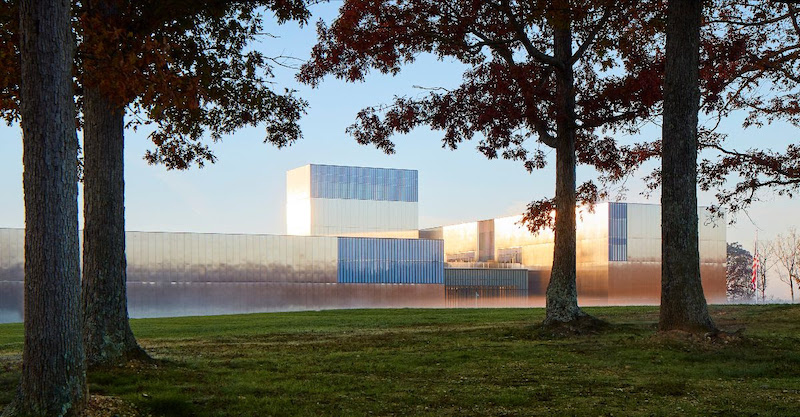The National Museum of the United States Army (NMUSA), a cultural institution that is the first to tell the story of the oldest branch of the United States military, recently completed and opened on Veterans Day.
Located 20 miles outside of Washington, D.C., the facility is designed to serve as a center of education, and the symbolic front door of the Army. The museum focuses on the individual soldier, not battles or wars, to tell a centuries-long narrative of honor, sacrifice, and valor.
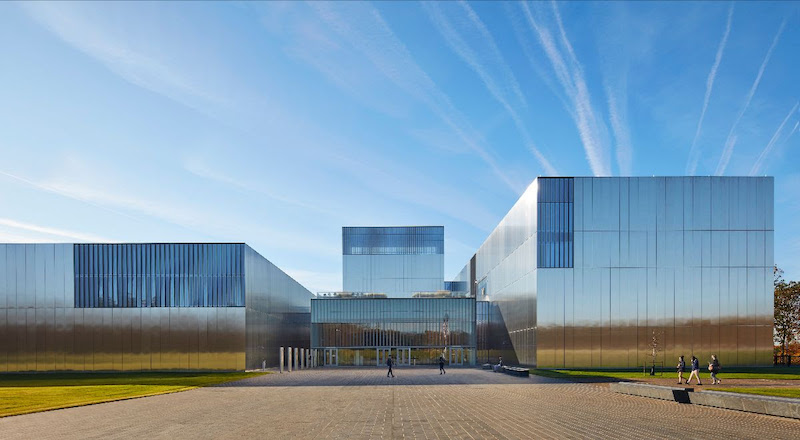
The LEED Silver-certified museum spans 84 acres across the Fort Belvoir Military Installation in Virginia and comprises a series of pavilions for exhibits and special events. The building leverages the site’s natural topography and rests atop a plateau to evoke a sense of monumentality. SOM’s design and planning for the future of the site includes a quiet memorial garden, a parade field and grandstand, and an Army Trail with interpretive stations.
Symbolism is at the core of the museum’s design. The symbolic experience begins with the access road, which offers a glimpse of the stainless steel-clad museum through the tress and across a long meadow. The museum rises to 100 feet at its peak, and its facade is composed of a regular grid of laser-cut stainless steel panels that establish a sense of rigor and discipline that are central to the design. At the corner of each pavilion, recessed glass panels alternate with painted aluminum fins to add a sense of dynamism. The complex lies on a three-foot grid system with every joint and edge of the building falling on each subdivision with precision, meaning the aluminum fins are spaced 18 inches apart to fall exactly on the edges of the panels.
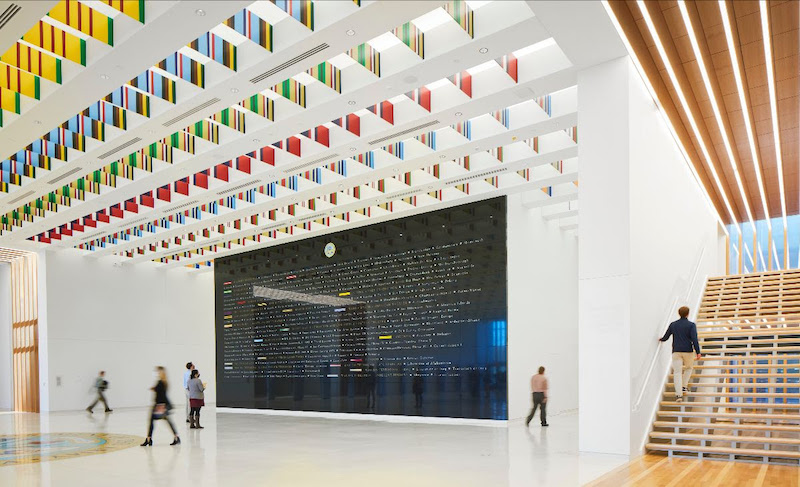
Inside, the symbolism continues with stainless steel pylons sharing individual soldier stories and leading visitors from the promenade, through the vestibule, and into the exhibition hall. The grand lobby, which can be used as an event space, includes the Department of the Army’s emblem inscribed on the terrazzo floor and a black granite wall that lists every campaign from the Army’s history. Above, a coffered ceiling with 22 rows of translucent, laminated glass panels match the colors of the campaign streamers from the Army’s past.
See Also: First rendering of the National Medal of Honor Museum unveiled
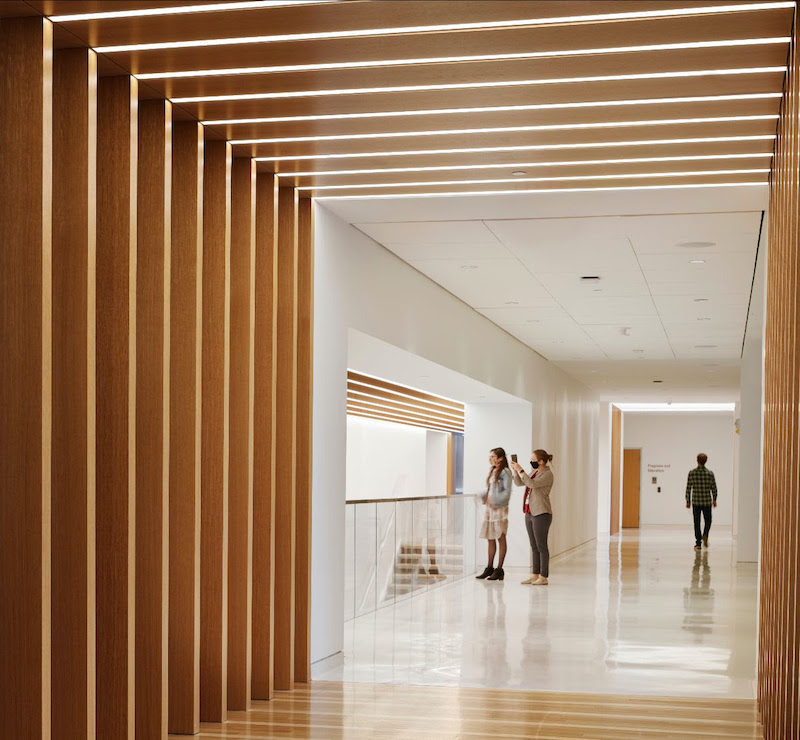
Retail, a cafe, the first of three landscaped terraces, and exhibition spaces including a 300-degree theater surround the lobby. A monumental staircase leads visitors to additional exhibition spaces on the second floor.
Glass and wood thresholds connect each pavilion to signify transitions between spaces and provide views outside. On the third floor a wood-clad Veterans’ Hall serves as an event space supplementing the lobby. The Veterans’ Hall connects to the Medal of Honor Garden. Here, a 10-foot-tall black granite wall is engraved with the names of every medal recipient.
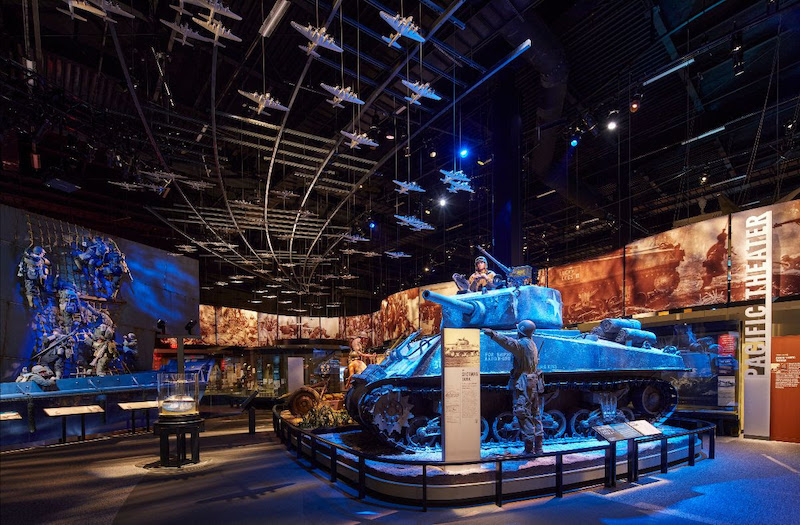
Sustainable features include increased insulation, improved glazing, high-efficiency LED lighting, automatic daylighting controls and occupancy sensors, and a green roof.

Related Stories
| Jan 19, 2011
Industrial history museum gets new home in steel plant
The National Museum of Industrial History recently renovated the exterior of a 1913 steel plant in Bethlehem, Pa., to house its new 40,000-sf exhibition space. The museum chose VOA Associates, which is headquartered in Chicago, to complete the design for the exhibit’s interior. The exhibit, which has views of five historic blast furnaces, will feature artifacts from the Smithsonian Institution to illustrate early industrial America.
| Jan 19, 2011
Museum design integrates Greek history and architecture
Construction is under way in Chicago on the National Hellenic Museum, the nation’s first museum devoted to Greek history and culture. RTKL designed the 40,000-sf limestone and glass building to include such historic references as the covered walkway of classical architecture and the natural wood accents of Byzantine monasteries. The museum will include a research library and oral history center, plus a 3,600-sf rooftop terrace featuring three gardens. The project seeks LEED Silver.
| Nov 23, 2010
The George W. Bush Presidential Center, which will house the former president’s library
The George W. Bush Presidential Center, which will house the former president’s library and museum, plus the Bush Institute, is aiming for LEED Platinum. The 226,565-sf center, located at Southern Methodist University, in Dallas, was designed by architect Robert A.M. Stern and landscape architect Michael Van Valkenburgh.
| Nov 2, 2010
Cypress Siding Helps Nature Center Look its Part
The Trinity River Audubon Center, which sits within a 6,000-acre forest just outside Dallas, utilizes sustainable materials that help the $12.5 million nature center fit its wooded setting and put it on a path to earning LEED Gold.
| Oct 13, 2010
Tower commemorates Lewis & Clark’s historic expedition
The $4.8 million Lewis and Clark Confluence Tower in Hartford, Ill., commemorates explorers Meriwether Lewis and William Clark at the point where their trek to the Pacific Ocean began—the confluence of the Mississippi and Missouri Rivers.
| Oct 12, 2010
Gartner Auditorium, Cleveland Museum of Art
27th Annual Reconstruction Awards—Silver Award. Gartner Auditorium was originally designed by Marcel Breuer and completed, in 1971, as part of his Education Wing at the Cleveland Museum of Art. Despite that lofty provenance, the Gartner was never a perfect music venue.
| Oct 12, 2010
Cuyahoga County Soldiers’ and Sailors’ Monument, Cleveland, Ohio
27th Annual Reconstruction Awards—Gold Award. The Cuyahoga County Soldiers’ and Sailors’ Monument was dedicated on the Fourth of July, 1894, to honor the memory of the more than 9,000 Cuyahoga County veterans of the Civil War.
| Aug 11, 2010
JE Dunn, Balfour Beatty among country's biggest institutional building contractors, according to BD+C's Giants 300 report
A ranking of the Top 50 Institutional Contractors based on Building Design+Construction's 2009 Giants 300 survey. For more Giants 300 rankings, visit http://www.BDCnetwork.com/Giants
| Aug 11, 2010
Jacobs, Arup, AECOM top BD+C's ranking of the nation's 75 largest international design firms
A ranking of the Top 75 International Design Firms based on Building Design+Construction's 2009 Giants 300 survey. For more Giants 300 rankings, visit http://www.BDCnetwork.com/Giants
| Aug 11, 2010
Walter P Moore wins top award for Nerman Museum of Contemporary Art
With structural engineering from Walter P Moore, Nerman Museum of Contemporary Art has won the New Buildings Under $30 Million project category in the 2009 Structural Engineers Association of Kansas & Missouri (SEAKM) Awards Program.


